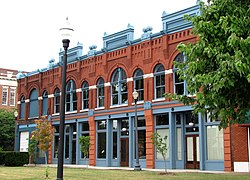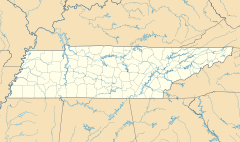Emory Place Historic District
| ||
 | ||
6-12 Emory Place
| ||
| Location: | Roughly bounded by Broadway, N. Central, Emory, Fifth, East Fourth, and King Knoxville, Tennessee | |
|---|---|---|
| Coordinates: | 35°58′26.65″N 83°55′20.94″WCoordinates: 35°58′26.65″N 83°55′20.94″W | |
| Area: | approximately 10 acres (4.0 ha)[1] | |
| Built: | 1880–1930 | |
| Architect: | Charles I. Barber, Albert Baumann, Sr., Dean Parmalee, R. F. Graf, etc. | |
| Architectural style: | Romanesque Revival, Neoclassical Revival | |
| Governing body: | Private | |
| NRHP Reference#: | 94001259 | |
| Added to NRHP: | November 10, 1994 | |
Following railroad construction in the 1850's, Knoxville slowly expanded northward. In 1890, the "Dummy Line," a railroad line connecting Knoxville and Fountain City, was established, with what is now Emory Place as its southern terminus. A farmers' market and several small industrial and commercial firms developed adjacent to the train station to take advantage of the influx of customers and transportation advantages. While Emory Place declined with the dismantling of Knoxville's trolley system in the late 1940's, many of its late-nineteenth and early-twentieth century buildings still stand, and have been restored.
Location
The Emory Place Historic District is situated around a triangular-shaped area created by the intersections of Broadway and Central Street on the north, Broadway and Fifth Avenue on the southwest, and Central and Fifth on the southeast.Interstate 40 and the Southern Railway tracks divide the district from downtown Knoxville to the south. The Fourth and Gill neighborhood lies to the north, and Old Gray Cemetery lies opposite Broadway to the west.
Emory Place itself is a cross street connecting Central and Broadway. The street was once a wide avenue, much of which has been converted into parking space. Gay Street, downtown Knoxville's main thoroughfare, traverses the Emory Place Historic District, and terminates at Emory Place.
History
Early history
What is now Emory Place was mostly farmland during the first half of the nineteenth century. In the 1850's, two events took place that led to the development of the Emory Place area. The first was the establishment of Old Gray Cemetery in 1850, which served as a de facto public park, and drew pedestrians to the area. The second event was the construction of the railroad, which reached Knoxville in 1855, pushing the city's northern limits to what is now the Southern Railway tracks. The Emory Place area was annexed in 1855.On July 20, 1863, at the height of the Civil War, Union General William P. Sanders placed artillery along what is now the section of Fifth Avenue between Broadway and Central, and proceeded to shell Knoxville, which was then held by Confederate forces. Return fire scattered the Union artillery, however, and Sanders was forced to retreat. During the Siege of Knoxville in late 1863, Confederate lines stretched across roughly the same area.
After the war, Knoxville continued to expand northward. By 1867, the Knoxville Foundry had been established near what is now the intersection of Broadway and Depot. Farmers from the rural areas north of the city began selling produce out of wagons along what is now Emory Place to Knoxvillians visiting Old Gray Cemetery, and by the late 1880s, Emory Place had become known as "Central Market."
The Dummy Line
In 1890, the Fountain City Railroad, commonly called the "Dummy Line," was built to connect Knoxville to the Fountain Head resort at Fountain City. A depot was built at the corner of Broadway and Emory Place that provided the railroad's southern terminus, and the area around the depot began to grow. A large, 33-stall market house was built for the Central Market farmers around the time of the railroad's completion. Small industries also sprang up near the depot, among them the Whittle and Spence Trunk Company (1890), the Knoxville Candy Company (1891), and the Walla Walla Gum Company (1896).Many of the new businessmen and residents of Emory Place were the children and grandchildren of Irish and German immigrants, who had come to Knoxville in previous decades to help build the railroads. The city's second Catholic church, the Holy Ghost, sprang up along North Central, and St. John's Lutheran Church was erected by second-generation German immigrants. At one point during this period, businessmen operating in the Emory Place district included several Irish saloon keepers and an Irish tinner, a Swiss barber, a Jewish tailor, a Jewish drugstore owner, and an African-American shoe maker.
"Emory Place" is named for Reverend Isaac Emory (1830–1904), a New York-born minister who moved to a farm north of Knoxville just after the Civil War, and spent several decades establishing Sunday schools across the state. In 1904, Emory was killed in the New Market train wreck, and a park adjacent to the Central Markethouse was renamed "Emory Park" in his honor. The park remained Knoxville's only urban park until it was removed in the 1950s and replaced with parking lots.
Twentieth Century
In 1905, the Dummy Line was replaced by a trolley, and Emory Place gradually became a residential neighborhood as many of its small industries failed or moved away. Several rowhouses and residential apartments were built along Central and Fifth, among them the Sterchi (now Sterchi Oaks) and the Lucerne. Knoxville High School was built in 1910, its location at the corner of Fifth and Central chosen in part for its proximity to the trolley station at Emory Place.With the dismantling of the trolley system in 1947 and the construction of the Magnolia Expressway (now part of I-40) in 1951, Emory Place began to decline. Car dealerships— starting with the Worsham-Stockton Motor Company (1922) and the Knoxville Buick Company (1927), both on North Gay— were the most prominent businesses at Emory Place until the 1970's.
Since the 1980's, many of the buildings at Emory Place have been rehabilitated, and several of the old rowhouses and hotels have been converted into condominiums. In 2010, a development group, Emory Place Partners, purchased several Emory Place properties with plans to rehabilitate and restore them for use as office and retail space.
Notable buildings
The Emory Place Historic District consists of 23 contributing buildings and one contributing object (the "Doughboy" statue on the front lawn of the Knoxville High School building). Most of the buildings were constructed in the early 1900s, with the two oldest– 6-12 Emory Place and 15-17 Emory Place– completed in 1890. Architectural styles represented in the district include Colonial Revival, Neoclassical, and Richardsonian Romanesque. The St. John's Lutheran Church, at the corner of Emory Place and Broadway, was listed individually on the National Register in 1985.Knoxville High School
Main article: Knoxville High School (Tennessee)
The Knoxville High School building is a two-story
Neoclassical/Beaux-Arts structure completed in 1910. The building was
designed by noted Knoxville architect Albert Baumann, Sr., of the firm Baumann Brothers,
and later of Baumann and Baumann. Knoxville High School operated out of
the building from 1910 until 1951, when it was split into four smaller
high schools. The Doughboy Statue on the school's front lawn was erected
in 1921 to commemorate Knoxville's World War I veterans.First Christian Church
The First Christian Church (211 W. Fifth Ave.), built in 1914, was designed by noted Knoxville architect Charles I. Barber. Barber also designed the church's adjacent office building and Sunday school building, which were both completed in 1929. The church is home to a Disciples of Christ congregation.The church is a two-story Neoclassical structure with Romanesque influences. The exterior walls consist of brick, with a marble cornice, marble panels in the side walls, and marble panels with angel carvings above the front entrance. The facade is fronted by six marble columns with Doric capitals, supporting a pediment with marble detailing.
The church's Sunday school building is a two-story Romanesque structure with a Spanish tile roof, and an arched entrance flanked by stone pilasters with Corinthian capitals. The church's educational and office building is a three-story brick structure with a Roman tile roof and arched double doors. The church, Sunday school, and office building surround a central courtyard, and all three buildings are connected by arched passageways.







No comments:
Post a Comment